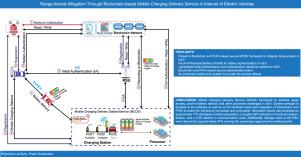基于区块链的电动汽车互联网移动充电配送服务缓解里程焦虑
IF 4.9
3区 计算机科学
Q1 COMPUTER SCIENCE, HARDWARE & ARCHITECTURE
引用次数: 0
摘要
车载自组织网络(VANETs)中传感器丰富的电动汽车(ev)已经将其转变为电动汽车互联网(IoEV)。气候友好型和低碳足迹电动汽车面临的挑战是:首先,充电站不可用、电池充电时间和电动汽车用户的容量导致的里程焦虑。其次,隐私泄露的威胁和基于软件的物联网安全的局限性。第三,缺乏确保交付承诺的电池和核实交付的机制。拟议的框架侧重于通过在移动充电交付服务(MCDS)地点交付可更换电动汽车电池来减少里程焦虑。通过集成区块链和puf (Physical unclable Functions)实现软硬件级安全。还引入了承诺电池验证(PoPB)机制来确保交付。实验结果和Scyther工具分析证明了所提出的框架的有效性和相对于现有工作的优越性。本文章由计算机程序翻译,如有差异,请以英文原文为准。

Range anxiety mitigation through blockchain-based mobile charging delivery service in Internet of Electric Vehicles
Sensor-rich Electric Vehicles (EVs) in Vehicular Ad-Hoc Networks (VANETs) have transformed it into the Internet of Electric Vehicles (IoEV). Identified challenges in climate-friendly and low-carbon footprint EVs are: First, range anxiety due to the unavailability of charging stations, battery charging duration and capacity in EV users. Second, the threat of privacy leakage and the limitations of software-based security in IoEV. Third is the absence of a mechanism to ensure the delivery of the promised battery and to verify delivery. The proposed framework focused on reducing range anxiety through the delivery of swappable EV batteries at locations as Mobile Charging Delivery Service (MCDS). The software and hardware-level security is provided by the integration of blockchain and Physical Unclonable Functions (PUFs). A Proof-of-Promised Battery (PoPB) mechanism is also introduced to ensure the delivery. Experimental results and Scyther tool analysis prove the effectiveness of the proposed framework and its superiority over recent works.
求助全文
通过发布文献求助,成功后即可免费获取论文全文。
去求助
来源期刊

Computers & Electrical Engineering
工程技术-工程:电子与电气
CiteScore
9.20
自引率
7.00%
发文量
661
审稿时长
47 days
期刊介绍:
The impact of computers has nowhere been more revolutionary than in electrical engineering. The design, analysis, and operation of electrical and electronic systems are now dominated by computers, a transformation that has been motivated by the natural ease of interface between computers and electrical systems, and the promise of spectacular improvements in speed and efficiency.
Published since 1973, Computers & Electrical Engineering provides rapid publication of topical research into the integration of computer technology and computational techniques with electrical and electronic systems. The journal publishes papers featuring novel implementations of computers and computational techniques in areas like signal and image processing, high-performance computing, parallel processing, and communications. Special attention will be paid to papers describing innovative architectures, algorithms, and software tools.
 求助内容:
求助内容: 应助结果提醒方式:
应助结果提醒方式:


